What is super moon? Vietnam will welcome super moon at any time in 2018?
- Admire the beautiful super moon image in the sky of Vietnam and the world
- The extremely rare astronomical phenomenon "Black Moon" will appear tonight
- Why does the Moon look bigger and closer when it is at the horizon?
In 2017 there is only one super moon, but by 2018 there will be 2 super moons . In fact, the next two full moons appear in January 2018 - will be super moon. So what is super moon? Vietnam will welcome super moon at what time?
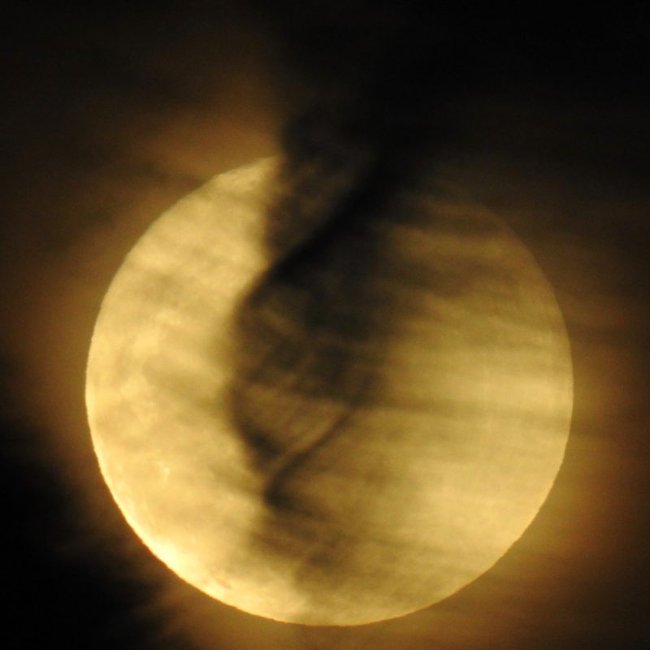 What is super moon? Vietnam will welcome super moon at any time in 2018? Picture 1 Michael de Grasse in Lake Havasu City, Arizona captured the super moon image on December 3, 2017 with the clouds hovering ahead.He wrote: "It's spectacular!"
What is super moon? Vietnam will welcome super moon at any time in 2018? Picture 1 Michael de Grasse in Lake Havasu City, Arizona captured the super moon image on December 3, 2017 with the clouds hovering ahead.He wrote: "It's spectacular!"
What is super moon?
Considered as the Earth's only natural satellite, the Moon moves around the Earth in an oval orbit. When moving to the extreme position - the closest distance to the Earth, the size of the Moon when viewed from Earth will be larger.
Especially when the Sun, Earth and Moon align in the right time with the Moon at the point. The Moon will then be brighter and much larger when viewed from the Earth, which is called the Super Moon or Super Moon (Supermoon) phenomenon. Compared to the size of the Moon at the farthest distance from Earth in orbit (telecom point), the Moon is 30% brighter and 14% larger when viewed from Earth at the time of its occurrence. Super moon phenomenon .
Super moon is a new moon or full moon located at the extreme close - the Moon's closest point to Earth in its monthly orbit. The astrologer, Richard Nolle , has coined the term ' supermoon - super moon ' since more than 30 years ago, but until now many astronomers still use it.
Is the super moon a hype? We think it is just a modern folklore. They have entered popular culture ( like Sophie Hunger's music video in this post ). And they can actually cause physical effects, such as high or low tide.
According to the super moon definition given by astrologer Richard Nolle, only the full moon in December 2017 is super moon. The next two super moons will appear in early 2018.
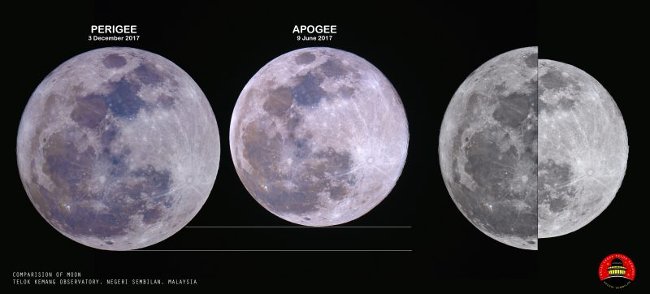 What is super moon? Vietnam will welcome super moon at any time in 2018? Picture 2 This is a comparison of the full moon in March 2017 at the ocean floor (the closest location to the Earth in the month) and the highest full moon of the year in June 2017 at the top of Muzamir Mazlan at Telok Kemang Observatory , Port Dickson, Malaysia.
What is super moon? Vietnam will welcome super moon at any time in 2018? Picture 2 This is a comparison of the full moon in March 2017 at the ocean floor (the closest location to the Earth in the month) and the highest full moon of the year in June 2017 at the top of Muzamir Mazlan at Telok Kemang Observatory , Port Dickson, Malaysia.
When will the next super moon appear?
By definition of astrologer Richard Nolle, the new moon (New Moon) or the full moon (Full Moon) has moved to the distance of 362,146 km (225,027 miles) of planet Earth, measured from the center of the Moon and Earth, to be considered super moon.
Based on this definition, 2017 has only one super moon, the 12th full moon . The super moon on December 3, 2017 is the first super moon in three super moons . Two full moons in January 2018 - will appear on January 2 and January 31 - are also considered super moon. As is the case, it is the second super moon among the three super moons that completely coincides with the time when the Moon is at its extreme position (the Moon's closest point to the Earth in that month). Therefore, in this three-moon series, super moon on January 2 will appear at the nearest and largest position.
Distance from full moon (takes place at 15:47 UTC, December 3, 2017): 357,987 km.
Distance of the extreme position on the Moon (takes place at 08:42 UTC, December 4, 2017): 357,492 km.
Full moon distance (takes place at 02:24 UTC, January 2, 2018): 356,846 km.
The distance of extreme positions on the Moon (takes place at 21:54 UTC, January 1, 2018): 356,565 km.
Full moon distance (takes place at 13:27 UTC, January 31, 2018): 360,199 km.
The distance is extremely close to the Moon (at 9:54 UTC, January 30, 2018): 358,995 km.
Some people will call the full moon on January 31, 2018, Blue Moon - Blue Moon ( a concept in the Western world that indicates the full moon phenomenon does not match a calendar month. Usually a year of a year The calendar has twelve full moons, the equivalent of a full moon every month because this is the second full moon in the same month . Moreover, this super moon will create a total solar eclipse.
We can expect super moon in the next third to recur after the 14th lunar month (14 times the full moon). By the way, the 14th lunar month represents the period of 1 year, 1 month and 18 days. In 2019, the second super moon in three super moons will appear - the nearest and largest super moon.
- Full Moon facts - Full moon you may not know yet
Super full moon in 2019:
Distance from full moon (January 21, 2019): 357,715 km.
Distance from the full moon (February 19, 2019): 356,846 km.
Distance from full moon (March 21, 2019): 360,772 km.
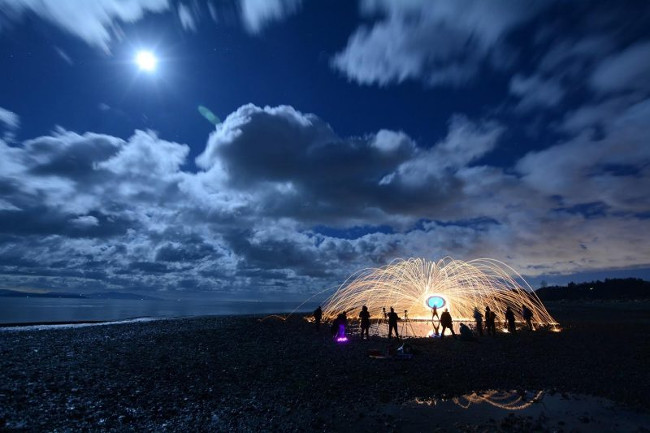 What is super moon? Vietnam will welcome super moon at any time in 2018? Picture 3 When observing with the naked eye, perhaps we will see that the super moon is not much larger than the moon at normal (although it looks brighter).However, Earth oceans feel the gravitational attraction of the super moon from a distance, causing a tide to rise and fall.
What is super moon? Vietnam will welcome super moon at any time in 2018? Picture 3 When observing with the naked eye, perhaps we will see that the super moon is not much larger than the moon at normal (although it looks brighter).However, Earth oceans feel the gravitational attraction of the super moon from a distance, causing a tide to rise and fall.
James Younger wrote on December 3, 2017: " I organized a super moon photography event at low tide at Beach View Island, Vancouver Island, BC and took a few photos ."
In 2018, a series of new super-moons will appear when the new moon reaches its extreme position on June 13, July 13 and August 11, 2018. The second Super Moon on July 13, 2007 2018in these three super moons will appear at the closest position to the super-moon in 2018. Of course, the new moon will not be visible to the naked eye, unless you are in a position to observe the phenomenon. partial eclipse on Friday, July 13, 2018.
Once again, the next three "moon" seasons of 2019 will appear after the 14th lunar month ( 14 new moons ): August 1 and August 30, plus September 28, 2019. Next That, the second super moon in three super moons will appear on August 30, 2019.
What is super moon? We confess: " A few years ago, in astronomy we never heard that term. The term has recently been popularly used ." The astrologer Richard Nolle defined the super moon as follows:
. a new moon or a full moon appearing at the Moon or nearly (about 90%) of Earth's closest access point with a specific orbit.
It is a fairly open definition, which is why there are so many super moons. Based on this definition, Nolle said:
On average, there will be 4 to 6 super moons each year.
Some super moon are full moon, others are new moon.In 2018, any full moon or new moon approaching 361,554.9 km of Earth is counted as a super moon .
In 2018, the extreme position is 356,564 km and the farthest point from the Earth is 406,464 km. This is the difference of 49,899 km, so 90% of this difference is 44,909.1 km (0.9 x 49,899 = 44,909.1). So any new full moon or moon is closer to 361,554.9 km (406,464 - 44,909.1 = 361,554.9). Earth's magnetic properties can all be super moon.
Some astronomers have complained about this name . but we like it! And it went into popular culture. For example, Supermoon is the title track of Sophie Hunger's 2015 album. It is a good song! Look in the video below:
So what do astronomers call this phenomenon before calling them super moon? We call them the full moon near the point ( perigee full moon ) or the new moon near the point ( perigee new moon ). Perigee - the near-polar position means lying near the Earth.
The moon is full, or the Earth is opposite the Sun, once a month. It is a new moon, more or less once a month. And every month, when the Moon orbits the Earth, it is closest to the Earth. This is called an extreme position. The Moon always moves to the farthest place once a month; This point is called apogee - the farthest point from the earth.
There is no doubt about that.Supermoon - super moon is a more attractive term than the new moon or the full moon.
We first became acquainted with the term super moon in 2011 when the media used it to describe the full moon that appeared on March 19, 2011. That day, the full moon fits proxigee. - the closest position of the year - to the nearest point, the largest full moon in 2011.
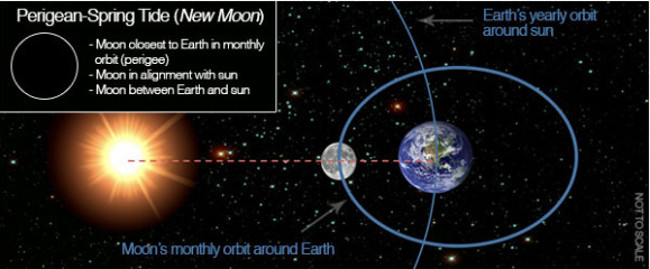 What is super moon? Vietnam will welcome super moon at any time in 2018? Picture 4
What is super moon? Vietnam will welcome super moon at any time in 2018? Picture 4
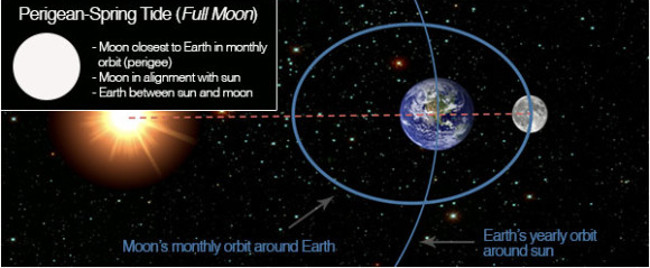 What is super moon? Vietnam will welcome super moon at any time in 2018? Picture 5 Images and captions via NOAA.
What is super moon? Vietnam will welcome super moon at any time in 2018? Picture 5 Images and captions via NOAA.
About three or four times a year, the new moon or the full moon coincides with the full moon - the closest point of the Earth.This event is often referred to as ' perigean spring tide '.The difference between near-tide and normal tides for all coastal areas is very small.In most cases, the difference is only a few inches from the normal tide.
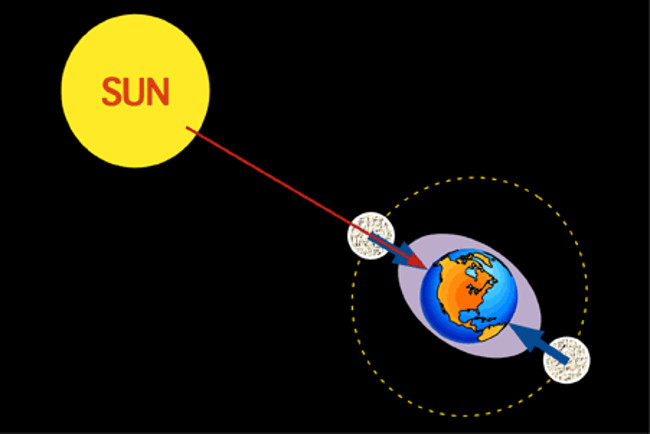 What is super moon? Vietnam will welcome super moon at any time in 2018? Picture 6 Images via physicalgeography.net.
What is super moon? Vietnam will welcome super moon at any time in 2018? Picture 6 Images via physicalgeography.net.
The new moon (left) and the full moon (right) - when the Earth and the Moon are aligned in time with the Moon at the point of close proximity - the interval between the rising and falling tide is greatest.This is called the spring tide.A super moon - a new moon or a full moon near the Earth - emphasizes the tide.
Spring tide will come with super moon. Will the tide be bigger than usual, the new moon in April, May and June 2017 and the full moon in December 2017? Yes, all full moons (and young moons) combine with the Sun to create tides larger than normal, but the new moons are more rounded than normal (or the new moons are closer than usual. ) higher tide.
Every month, on the day of the new moon, the Earth, Moon and Sun are all on the same line, the Moon in the middle. This upright position creates wide tidal currents, called spring tides . Special spring tide high and low on the same day.
The nearest new moon of the year appears on May 25 and the nearest full moon of the year that appears on December 3 strongly affects the spring tide, making it known to be near the tidal point . If you live along the ocean coast, watch high tide due to the appearance of a full moon at this point.
Will this high tide cause flooding? Probably not, unless the strong impact from the weather accompanies the spring tidal range. However, pay attention to the weather, because the storms have great potential to highlight the spring tidal point.
The most super-full moon day over the years and in the future. The moon has a periodic cycle, we can calculate the full moon and the moon at the near-point for a year, a month and 18 days.
The lunar month refers to the period between full moons, an average time of 29,53059 days. One month the Moon is closest to the Earth based on returning to its extreme position, the 27,55455 day period. So:
14 lunar months x 29,53059 days = 413,428 days
15 months of the Moon at the near-point x 27.55455 days = 413.318 days
Full moon and moon are near the point for about 413 days ( one year and 48 days ). Therefore, we can calculate the date the satellites are located in the nearest position ( ) in the past years and the future:
Full moon days from 2010 to 2020:
January 30, 2010 (356,593 km);
March 19, 2011 (356,575 km);
May 6, 2012 (356,955 km);
June 23, 2013 (356,991 km);
August 10, 2014 (356,896 km);
September 28, 2015 (356,877 km);
November 14, 2016 (356.509 km);
January 2, 2018 (356,565 km);
February 19, 2019 (356,761 km);
April 8, 2020 (356,907 km).
In 2017, there is no day when a full moon is in the near-point position (proxigee full moon - full moon proxigee.
But like many people, we will happily call them "super moon".
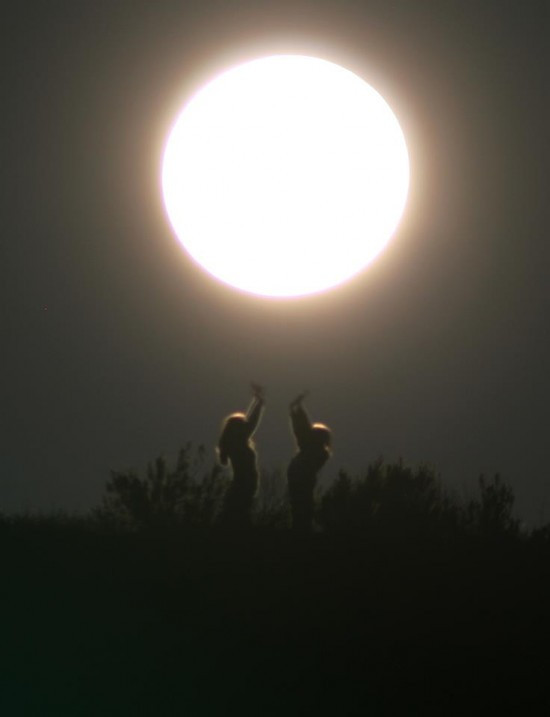 What is super moon? Vietnam will welcome super moon at any time in 2018? Picture 7 The image was taken from EarthSky, a Facebook user Rebecca Lacey in Cambridge, Idaho.
What is super moon? Vietnam will welcome super moon at any time in 2018? Picture 7 The image was taken from EarthSky, a Facebook user Rebecca Lacey in Cambridge, Idaho.
What does super moon look like?Most astronomers think that you can't detect any difference with the naked eye between a super moon and any normal moon, although some observers say you have can.
What is the Black Moon?
There are several definitions of Black Moon.It may be the third new moon in an astronomical season with 4 new moons, or the second new moon in the same calendar month.
 What is super moon? Vietnam will welcome super moon at any time in 2018? Picture 8
What is super moon? Vietnam will welcome super moon at any time in 2018? Picture 8
We have never heard the term Black Moon - Black Moon until the beginning of 2014. Black Horse is not a common term in the astronomical world. According to David Harper , " In recent years, this term has become popular by religious astrologers Wicca ".
This is the name used to refer to the second new moon appearing in the same month. For example, in January 2014, there were two new moons, the second super moon was not only super moon, but also known as Black Moon. So is Black Moon super moon? - The answer is "No".
In theory, the next Black Moon will appear on October 30, 2016. Sten Odenwald at astronomycafe.net lists some other names for the second super moon in a month: Moon Spinner, Finder's Moon, and Secret Moon.
In fact, no single definition is accepted about the Black Moon. The terms are often used to refer to any phenomenon related to the New Moon phase:
- The second new moon in a calendar month: The Black Moon times of this definition occur quite often, every 2.5 years.
- The new moon is the third time in a season with 4 New Moon: Astronomers divide the year into 4 seasons - spring, summer, autumn and winter. Usually each season has 3 months and 3 New Moon. If one season has 4 New Moon, the third new moon is called the Black Moon.
- A calendar month without New Moon: This can only happen in February. Then, January and March each month will have 2 New Moon, instead of 1 New Moon as usual.
- A calendar month without a Full Moon: About every 19 years, February has no Full Moon. Instead, January and March have 2 Full Moon. By this definition, the next Black Moon will occur in February 2018.
On December 3, 2017, the first super moon appeared in three super moons. Two full moons appeared in January 2018 - January 2 and January 31 - are also considered super moon.
See also: The moon has a life expectancy of about 4.51 billion years - bigger than we think and so does life
Having fun!
You should read it
- The biggest super moon in 70 years will appear on November 14
- Full Moon facts - Full moon you may not know yet
- Unexpected discoveries of the full moon
- True moon, snow moon and comet will appear together today
- The extremely rare astronomical phenomenon 'Black Moon' will appear tonight
- Admire the beautiful super moon image in the sky of Vietnam and the world
- Discover incredible facts about the Moon
- Don't miss the biggest super moon view in 2017 in the afternoon and tonight, Vietnam can see it
- How to directly see the phenomenon of super moon, blue moon and eclipse converging after more than 150 years
- Synthesize high resolution moon wallpaper on computer
- Admire the Super Moon in the sky of Hanoi at dawn 10/3
- 20 pictures of super beautiful splendor around the world on November 14
May be interested

Why is the Moon red like blood when the total lunar eclipse occurs?

NASA's 'breeding speed' accelerates wheat production three times faster

How to directly see the phenomenon of super moon, blue moon and eclipse converging after more than 150 years

Giant dust storms are taking away water on Mars

Bacteria on Earth live easily on Moon Enceladus

The Kepler Space Telescope is about to stop operating in the next few months






 Don't miss the biggest super moon view in 2017 in the afternoon and tonight, Vietnam can see it
Don't miss the biggest super moon view in 2017 in the afternoon and tonight, Vietnam can see it The biggest super moon in 70 years will appear on November 14
The biggest super moon in 70 years will appear on November 14 20 pictures of super beautiful splendor around the world on November 14
20 pictures of super beautiful splendor around the world on November 14 Admire the beautiful super moon image in the sky of Vietnam and the world
Admire the beautiful super moon image in the sky of Vietnam and the world Admire the Super Moon in the sky of Hanoi at dawn 10/3
Admire the Super Moon in the sky of Hanoi at dawn 10/3 How to directly see the phenomenon of super moon, blue moon and eclipse converging after more than 150 years
How to directly see the phenomenon of super moon, blue moon and eclipse converging after more than 150 years